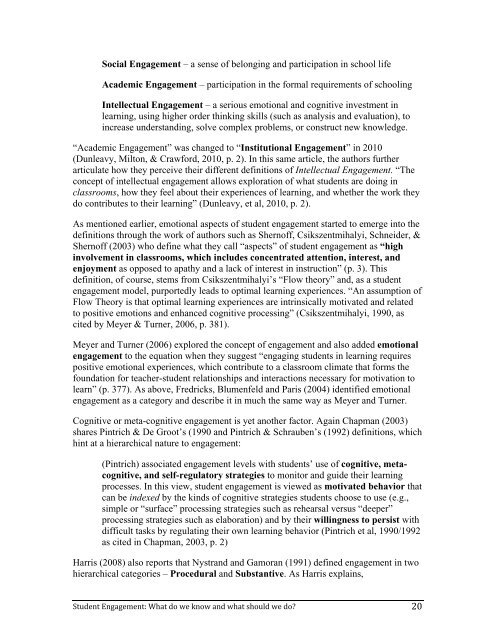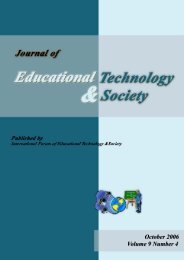Student Engagement: What do we know and what should we do?
Student Engagement: What do we know and what should we do?
Student Engagement: What do we know and what should we do?
You also want an ePaper? Increase the reach of your titles
YUMPU automatically turns print PDFs into web optimized ePapers that Google loves.
Social <strong>Engagement</strong> – a sense of belonging <strong>and</strong> participation in school life<br />
Academic <strong>Engagement</strong> – participation in the formal requirements of schooling<br />
Intellectual <strong>Engagement</strong> – a serious emotional <strong>and</strong> cognitive investment in<br />
learning, using higher order thinking skills (such as analysis <strong>and</strong> evaluation), to<br />
increase underst<strong>and</strong>ing, solve complex problems, or construct new <strong>know</strong>ledge.<br />
“Academic <strong>Engagement</strong>” was changed to “Institutional <strong>Engagement</strong>” in 2010<br />
(Dunleavy, Milton, & Crawford, 2010, p. 2). In this same article, the authors further<br />
articulate how they perceive their different definitions of Intellectual <strong>Engagement</strong>. “The<br />
concept of intellectual engagement allows exploration of <strong>what</strong> students are <strong>do</strong>ing in<br />
classrooms, how they feel about their experiences of learning, <strong>and</strong> whether the work they<br />
<strong>do</strong> contributes to their learning” (Dunleavy, et al, 2010, p. 2).<br />
As mentioned earlier, emotional aspects of student engagement started to emerge into the<br />
definitions through the work of authors such as Shernoff, Csikszentmihalyi, Schneider, &<br />
Shernoff (2003) who define <strong>what</strong> they call “aspects” of student engagement as “high<br />
involvement in classrooms, which includes concentrated attention, interest, <strong>and</strong><br />
enjoyment as opposed to apathy <strong>and</strong> a lack of interest in instruction” (p. 3). This<br />
definition, of course, stems from Csikszentmihalyi’s “Flow theory” <strong>and</strong>, as a student<br />
engagement model, purportedly leads to optimal learning experiences. “An assumption of<br />
Flow Theory is that optimal learning experiences are intrinsically motivated <strong>and</strong> related<br />
to positive emotions <strong>and</strong> enhanced cognitive processing” (Csikszentmihalyi, 1990, as<br />
cited by Meyer & Turner, 2006, p. 381).<br />
Meyer <strong>and</strong> Turner (2006) explored the concept of engagement <strong>and</strong> also added emotional<br />
engagement to the equation when they suggest “engaging students in learning requires<br />
positive emotional experiences, which contribute to a classroom climate that forms the<br />
foundation for teacher-student relationships <strong>and</strong> interactions necessary for motivation to<br />
learn” (p. 377). As above, Fredricks, Blumenfeld <strong>and</strong> Paris (2004) identified emotional<br />
engagement as a category <strong>and</strong> describe it in much the same way as Meyer <strong>and</strong> Turner.<br />
Cognitive or meta-cognitive engagement is yet another factor. Again Chapman (2003)<br />
shares Pintrich & De Groot’s (1990 <strong>and</strong> Pintrich & Schrauben’s (1992) definitions, which<br />
hint at a hierarchical nature to engagement:<br />
(Pintrich) associated engagement levels with students’ use of cognitive, metacognitive,<br />
<strong>and</strong> self-regulatory strategies to monitor <strong>and</strong> guide their learning<br />
processes. In this view, student engagement is vie<strong>we</strong>d as motivated behavior that<br />
can be indexed by the kinds of cognitive strategies students choose to use (e.g.,<br />
simple or “surface” processing strategies such as rehearsal versus “deeper”<br />
processing strategies such as elaboration) <strong>and</strong> by their willingness to persist with<br />
difficult tasks by regulating their own learning behavior (Pintrich et al, 1990/1992<br />
as cited in Chapman, 2003, p. 2)<br />
Harris (2008) also reports that Nystr<strong>and</strong> <strong>and</strong> Gamoran (1991) defined engagement in two<br />
hierarchical categories – Procedural <strong>and</strong> Substantive. As Harris explains,<br />
<strong>Student</strong> <strong>Engagement</strong>: <strong>What</strong> <strong>do</strong> <strong>we</strong> <strong>know</strong> <strong>and</strong> <strong>what</strong> <strong>should</strong> <strong>we</strong> <strong>do</strong>? 20












